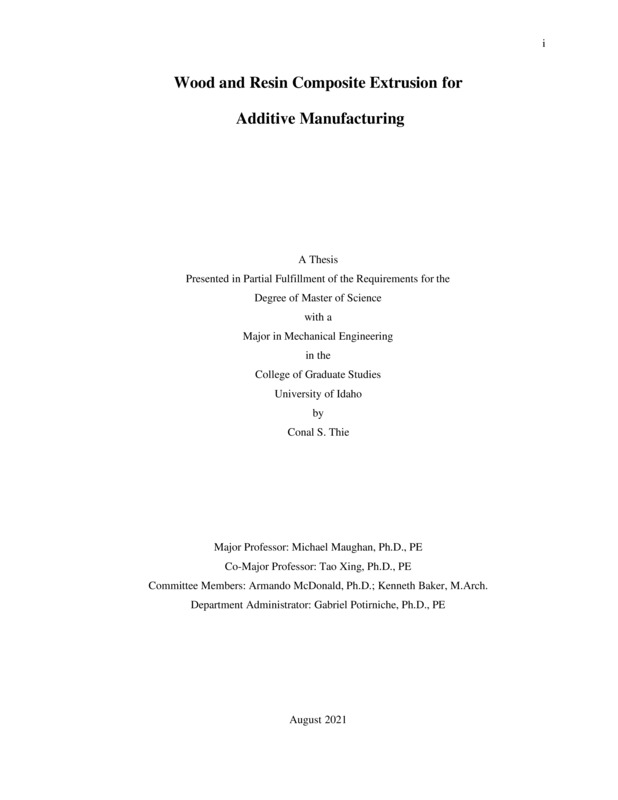Wood and Resin Composite Extrusion for Additive Manufacturing
Thie, Conal. (2021-07). Wood and Resin Composite Extrusion for Additive Manufacturing. Theses and Dissertations Collection, University of Idaho Library Digital Collections. https://www.lib.uidaho.edu/digital/etd/items/thie_idaho_0089n_12197.html
- Title:
- Wood and Resin Composite Extrusion for Additive Manufacturing
- Author:
- Thie, Conal
- ORCID:
- https://orcid.org/0000-0003-1412-8120
- Date:
- 2021-07
- Embargo Remove Date:
- 2022-09-01
- Program:
- Mechanical Engineering
- Subject Category:
- Mechanical engineering
- Abstract:
-
Additive manufacturing is a quickly growing manufacturing technique with a multitude of applications. It has the ability to rapidly manufacturing geometries that other techniques cannot. Additionally, it produces very little waste material and can use recycled materials. Additive manufacturing is becoming popular in the building construction industry. Currently, concrete is the primary additive manufacturing material being used in the construction industry. Wood-based composites have yet to be used in additive manufacturing for the construction industry because a method to use high wood content composites in additive manufacturing has not been developed. This study details the development of a wood-based composite extrusions method for additive manufacturing. A screw extruder was designed and constructed that could extrude wood-based composites with high wood content. This extruder produced many composite samples of various wood element sizes and resin content that were then cured. The cured sample sets were tested using a 3-point bend test. Samples were oven cured at different temperatures and time periods. It was determined that the rate at which the samples were cured did not affect the bending properties of the composite. For a sample made with wood element size less than 40 mesh and cured for two days at 50°C, the bending strength and Young’s modulus were 24.7 MPa and 4.6 GPa respectively. These mechanical properties are relatively close to OSB and fiber board. Thus, the extruded wood-based composites are suitable to replace traditional composites based on strength and modulus performance. Capillary rheology was performed to test the properties of the wood-based composite during extrusion. A custom capillary rheometer was designed and fabricated to perform these tests. The viscosity of the composite was found to be non-Newtonian and shear-thinning. A power-law model was used to characterize the viscosity. The power-law model was then used in a CFD model to simulate the capillary rheology extrusion. The CFD model was able to simulate the extrusion pressure of the capillary rheometer within 1.6% error, compared to the experimental value.
- Description:
- masters, M.S., Mechanical Engineering -- University of Idaho - College of Graduate Studies, 2021-07
- Major Professor:
- Maughan, Michael; Xing, Tao
- Committee:
- McDonald, Armando; Baker, Kenneth
- Defense Date:
- 2021-07
- Identifier:
- Thie_idaho_0089N_12197
- Type:
- Text
- Format Original:
- Format:
- application/pdf
- Rights:
- In Copyright - Educational Use Permitted. For more information, please contact University of Idaho Library Special Collections and Archives Department at libspec@uidaho.edu.
- Standardized Rights:
- http://rightsstatements.org/vocab/InC-EDU/1.0/

